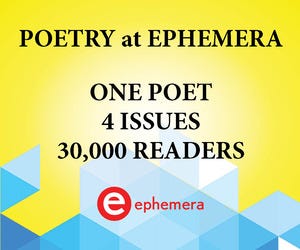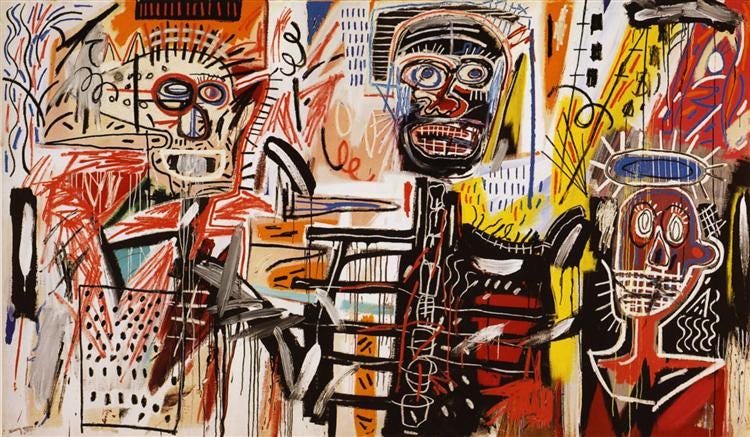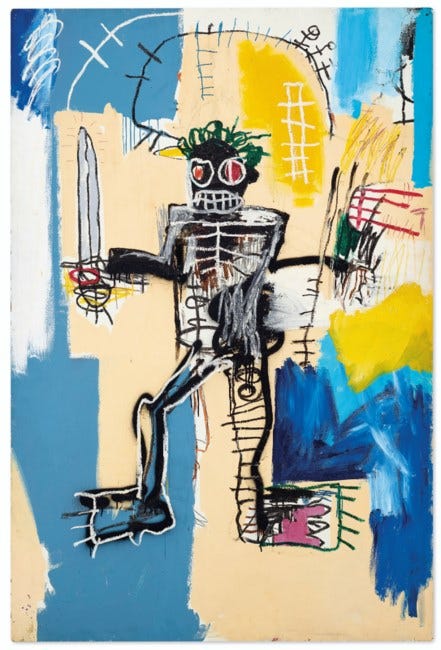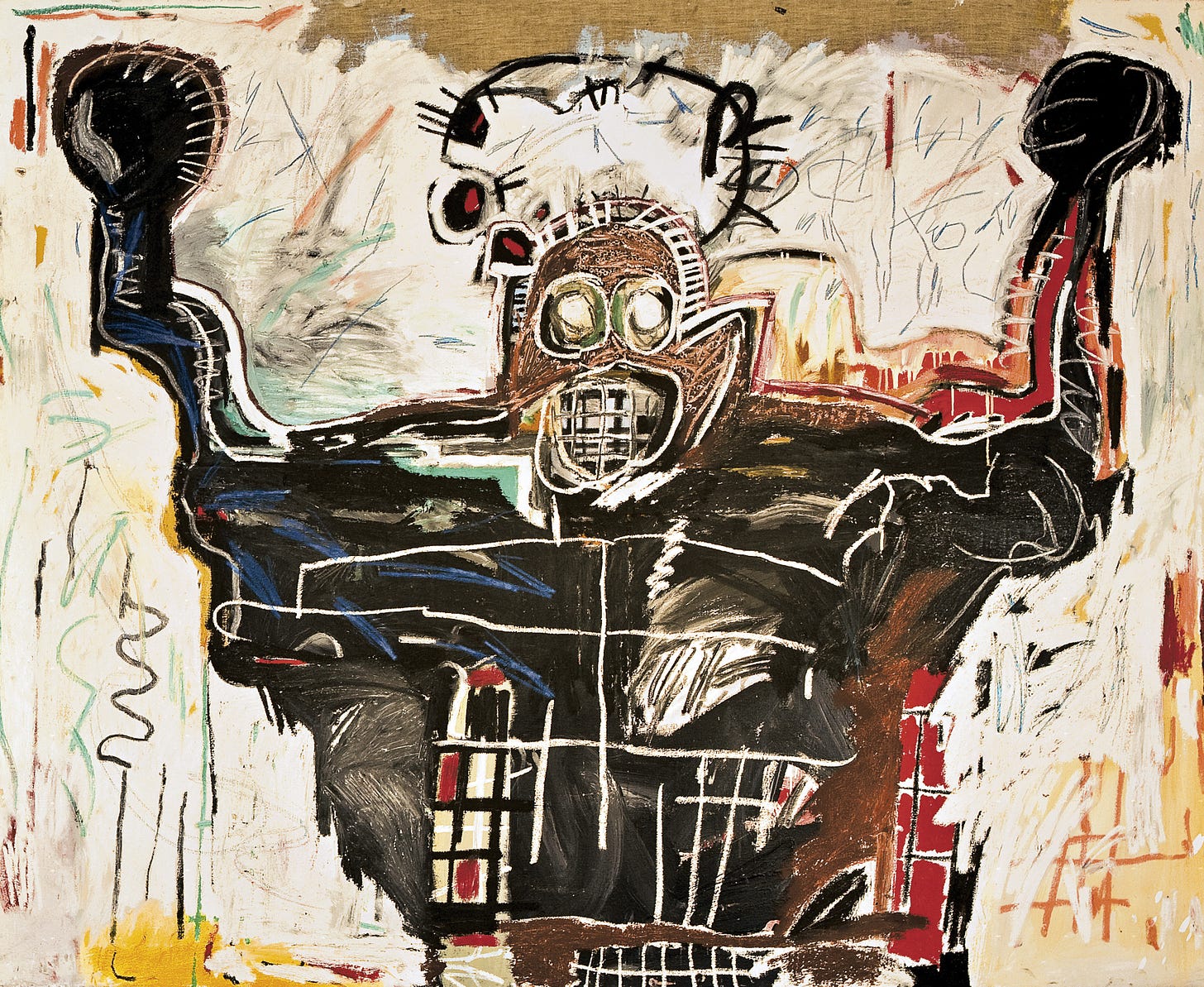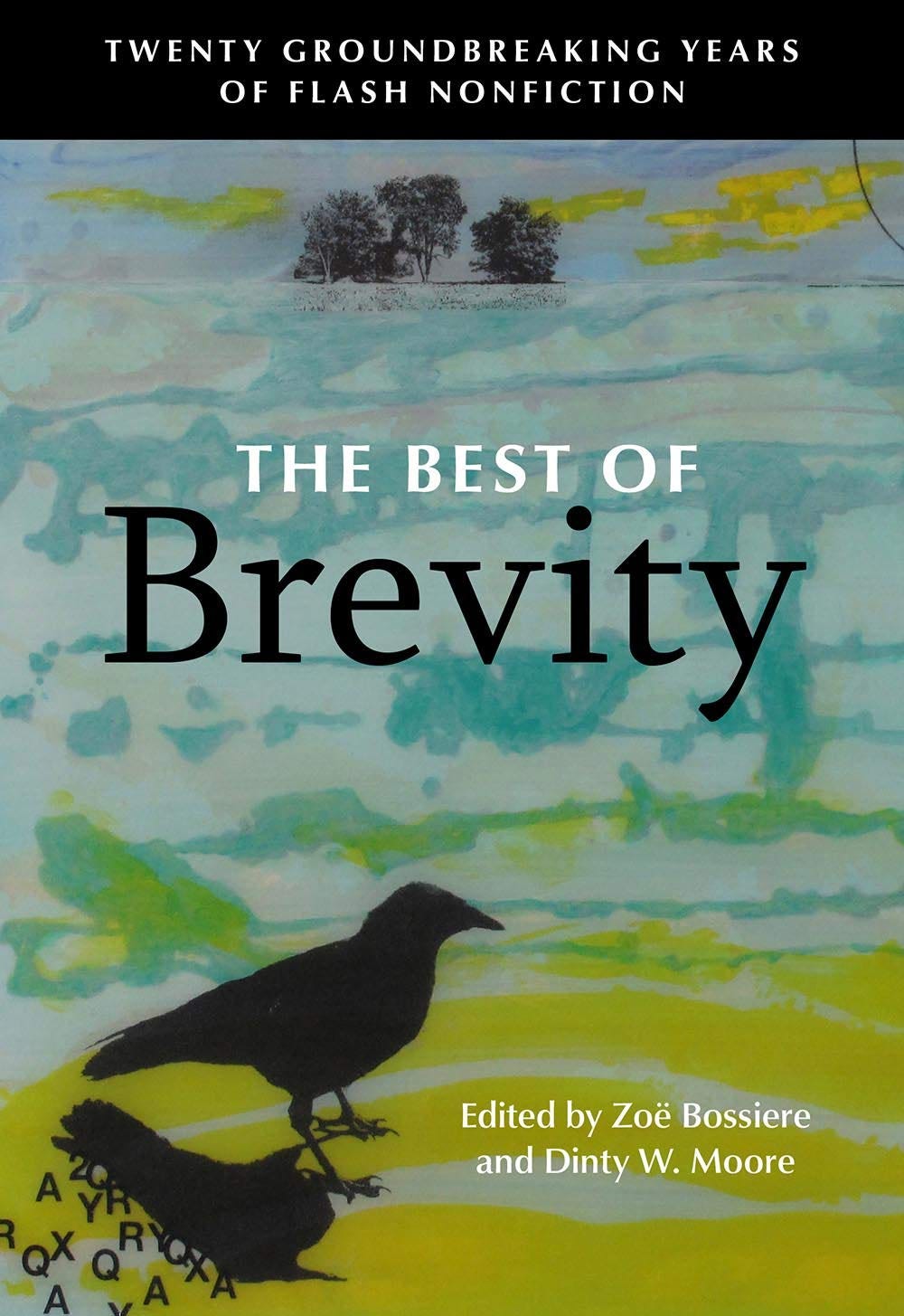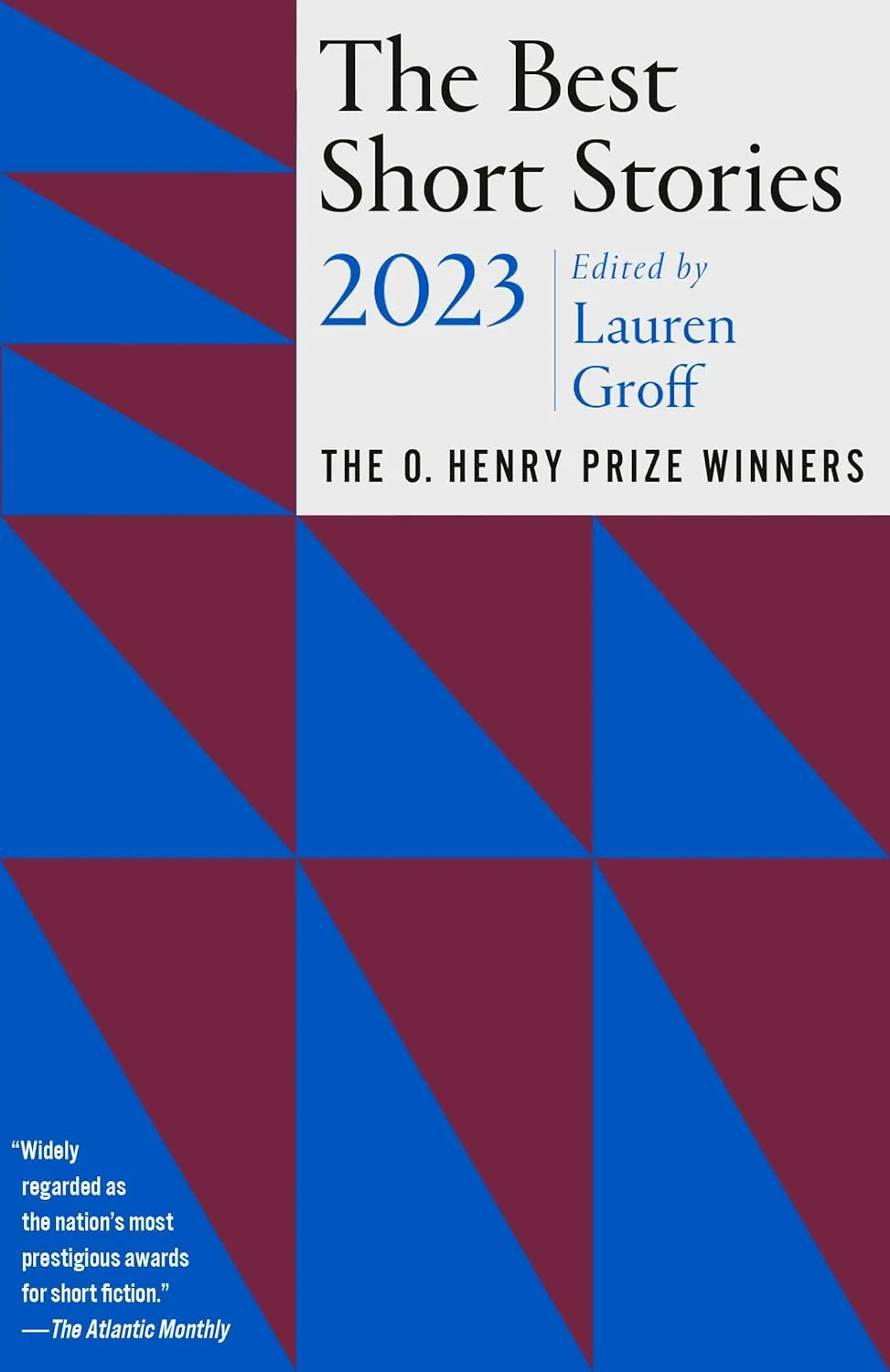Welcome to the Ephemera Newsletter, Abokai! (Hausa for “friends”)
Thank you to all who submitted to poetry in December and especially to our finalist, Sam Stokley, who will be the poet for the month! You can review his poems altogether once they publish as well as his artist statement and bio on this dedicated post on our substack page. We thank you for checking out Sam’s work.
On to our standard content matters: Won’t you please check out last week’s issue if you missed it.
And here are some reminders:
Call For Submissions: Submissions are in for the February issues. We look forward to reading! We are open for March now. January 31 is the deadline. If you are a paid subscriber to Ephemera, you can submit to poetry @ Ephemera for free as a membership perk! (We email you a secret link at the end of the month). Free subscribers and anyone else can submit, too, with the reading fee and can submit up to 10 poems. Paying the reading fee will grant you 1-month paid access to Ephemera’s full letter. Learn more or:
In Brief…this week’s features:
Thoughts on The Doors and their most covered track, “Light My Fire.”
Thoughts on Basquiat and his neo-expressionist work and too-brief life.
December’s poet, Sam Stokley and his first of four poems, “This) Enormity”
New Feature: Literary Films where we select an interesting movie we’ve seen that dramatizes the life of a writer or writers or artists, particularly we’re interested in biopics, and apropos genre selections.
This month: Julian Schnabel’s Basquiat
Our weekly lists:
3 magazines with open calls
3 awards/prizes
3 recent job listings for editors and writers.
**No sponsor this issue: Sponsor our letter! Reach out to info@Litbreaker.com to advertise with us.**
More ephemera: check out an Interesante selection, a brief clip of Ray Bradbury discussing being creative in the now and more; Book Recs, bonus content, and our mini-essays to start!
Support us on Bookshop - See our past book recs and others. A highly curated list.
Merci. Danke. Kiitos. 고마워 Go-ma-wo. Cảm ơn. Xiè xiè.
Ephemera
Dear Readers,
Oh those pesky obligations, those familial and fraternal and congenial commitments we make around what we’ve dubbed the holidays, plus lead-in and lead-out time. Last week we were still in cool down mode. Now, we’re excited to ford the gulf that we’ve let come between ourselves and our creative work. Sure, we took our own advice on finding bits of time, taking notes, actively, creatively reading, defamilializing our experiences, reassessments ex post facto to find kernels of inspiration, irregularity, bliss or radical boredom. Somewhere in the subconscious, surely upon review of anything hastily scribbled, we’ll gain access to and forge out of the ore of all of our requirements a cutting, handsome amalgam. Yes, we’ve done it before. Being middle aged, these routines give meaning to eternal occurrence. There’s a symbolic and ritualistic importance to these transitions and the demarcation of. Take note. Look at the skies—by the way, have you heard of parsec-sized so-called “structures” formed by enormous gravity filaments, supposedly, such as this recently discovered South Pole Wall?—and let yourself be properly awed and invigorated. Let’s get back to our plans and work and desks and words and wrangling. Ah, freezing January. No better time to be cocooned away.
“Absence is to love what wind is to fire; it extinguishes the small, it inflames the great.”
—Roger de Rabutin
Four notebooks. Several new literary works. A lineup of several tomes temporarily abandoned in media res. We’ll be reading to fill ourselves. Our notes, the works of others, some classics, some contemporary greats, some peers. This is our way to regain entry into the creative space after these aforementioned absences. Ack! We were a tad impoverished for having been gone. Apologies salvaged desk. We atone, deer swivel chair with once-fluffy pillow, neglected throe, un-electrified vintage lamp. We beg forgiveness spine-cracked books laid face down, sunning in the too-ephemeral afternoon light their only warmth. Apologies chaise we never use. Apologies room. Apologies metal straw and backup phone charger. My bad unused pen. Oh, and we beg of you, prostrate ourselves, dear writing laptop with the non-functional internet card. We were gone too long. Please, oh please, work still. Sage as an offering. This next morning, we swear, we’ll be pleasantly humming with coffee, space heater activated (apologies to you too cheap thing that has outworked our wildest expectations), digits warmed and, lo! ye creative god-entities, new fascinating things tongue-tip primed ready to be licked alive. We’re back at it. We hope everyone else is there or arriving not a moment too soon. My our absence be a fiery.
Godiya!
(Gratitude)
Poetry by Sam Stokley
This) Enormity
My body makes me lie.
(Maybe yours, too, forces half-truths.) The sandman each night
chooses bodily realestate for an eruption of blisters
bigger than most can dream,a blip in the end despite
their relative (to you,to them, to anyone without
this) enormity.Make a fist (be thankful
for joints, opposabledigits), thumb tucked
however you see fit. Thatfull of blood, hanging
off my body. Lance it, dama rose deluge.
It’s barely spring & alreadyI seek the cold, sterile rooms—
the intimacy of perfect conditions,respiration rates steady,
out equaling in. A breeze.We’re phototrophs
like cats or the boxedvine searching for nearby
shine. As kids in a classroomwe duct-taped a seedling’s hole shut
and the green huddled into itselfbefore wilting, too knotted up
to find a way into ultra(violet.
Reference: OED historical Thesaurus
A quick reminder that the Oxford English Dictionary website has a fascinating and useful website with a historical thesaurus search function. As a “getting back into the swing of things” mini-habit, we’ve been lost these last few days perusing the historical records of random words, looking into the quotations tabs and historical tabs. Maybe it’s obvious, but we can’t help but mention how extended uses, origins, related words and historical examples has aided our word recall and the artful use of words. Play around on the website:
Buy the Oxford Dictionary of Word Origins (We did)
Music: The Doors
We’ve recently found ourselves heavily intrigued by homage, sampling, and covers in music. Previously, we looked at The Weeknd’s sampling of two songs and, in subsequent issues, those sampled songs. This week we’re turning our attention to The Doors’ “Light My Fire,” because, well, it’s a good song and has staying power evidenced by, amongst other things, the litany of cover versions out there. A little deep dive on versions reveals there’s several dozen spanning from the year the song officially released in 1967, which is certainly complimentary, to the 20-teens. By many, “Light My Fire,” is considered The Doors’ quintessential track. At the time of its release, it sold over nine-hundred thousand singles. Late, in 2018, it was certified digital gold with one million digital units sold. Currently, on Spotify, The Doors earns nearly eleven million listeners per month. This is a well-known, well-liked band, yet there are plenty of those who do not have a song covered nearly as often across music genres. To name a select few, Jackie Wilson and Jose Feliciano (1968), Erma Franklin, Africa, and Stevie Wonder (1969), Al Green (1970), Beastie Boys (1995), UB40 (2000), and Alicia Keys (2011). Etta James is in there somewhere as well.
As many know, The Doors formed in Los Angeles in the ‘60s and quickly became popular if but also controversial in some ways, though nonetheless influential. Classified as Acid Rock, jazzy, and Psychedlic Rock, with R&B and other influences, they executed a unique sound with a broad appeal and utilized the versatility of rock by infusing their music with interesting elements, such as the organ in “Light My Fire.” Their run was short-lived because of Jim Morrison’s death in 1971, which likely contributes to their mystique and legacy in the way the premature death of prominent artists (be they musicians or writers) has been known to do (see also below: Basquiat). Maybe not terribly important, but the origin of the band’s name has always intrigued us, the doors reference being one of Huxley’s Doors of Perception (which in turn was a Huxley reference to Blake—literary homage galore), which likely explains some of their more psychedelic sounds and lyrics, some of the ostensible cerebralism.
“I wrote it at my parent’s house, in the room where the piano was,
although I wrote in on the guitar.”
—The Doors’ guitarist, Robby Krieger in Songwritingmagazine
We include the above pull quote because of how quotidian it is, how humble the origins of a great song. Good things can come of even banal or comfortable circumstances, a point useful to keep in mind for writers—we sacrifice earnings, most of us, in pursuit of our writing ideals, in favor of hours of quiet time doing a craft which amounts, much of the time, to simply thinking, day-dreaming, and a whole lot of erasure; parents’ houses or cheap venues being as good a place as any to get your thoughts worked out. Further, as we’ll discuss in subsequent issues this month, there’s something about this song, written in several keys in interesting, not-often-used-in-rock chords, infused with jazz elements and, signally, that intriguing organ, something about it that opens ones ears to hear a range of possibilities. You can glom on to the whole piece, or any number of elements, the universal but also oddly specific lyrics, the odd rhythm drummed out, the interesting guitar play and all the nuance Morrison’s voice brings to bear. It has us thinking of epic literary work that has been re-created, homaged, and otherwise referenced time and time again; a few easily-referenced works being Dante’s The Divine Comedy, The Odyssey, Hamlet, and versions of Bronte’s work. We’re thinking of recreations and or direct re-envisionings vs allusion or pastiche. The mentioned literature contains universal references in a way that can be appealing to a variety of readers, in a way that can be repurposed in new contexts, built upon, can become a theme in a new work in conversation. Listen to “Light My Fire” several times over and you’ll see the universal, a foundational work that can be added to, subtracted from, paired down, gussied up, and otherwise re-worked while still being its core self.
A bit about how the song came to be with songwritingmagazine.co.uk
Writers Submit: 3 Magazines
A well known journal founded in 1999 at Georgia College, where the magazine continues to publish writers in all genres. The magazine has published many writers early in their careers alongside established writers. DEADLINE JANUARY 31
The online magazine is reading work in all genres. They focus on transformative work and have published both emerging and established writers in each genre. They’ve published since 2016. DEADLINE JANUARY 31
The online and print magazine was founded in 1973, and is published by University of Montana. They are reading in all genres, and offer many publication opportunities throughout the year for both online and print publication. DEADLINE FEBRUARY 1
Weekly Artist: Jean-Michel Basquiat
Jean-Michel Basquiat’s meteoric rise from his putative coming out in 1980 to his death at age 27 in 1988 colors much of the artist’s legacy—coincidentally, as it does with The Door’s lead singer, Jim Morrison, The Doors being our music feature this week. Unlike Morrison, however, Basquiat’s rise, vis a vis the value of his art, continues to this day, with works routinely selling at auction for 10s of millions of dollars and his most expensive piece, Untitled (1982), selling for $110 million several years ago. Basquiat’s life, a sort of fraught rags to riches and fame followed by a fall story, one that continues to inspire artists while serving as a warning of the consequences of too-fast-to-fame when combined with liberal drug use, began in lower-middle class Brooklyn in 1960, born to Puerto Rican and Haitian parents. He was encouraged in his arts interests while in New York though the family split and he and his siblings went to live with their father, moving for a time to Pueto Rico before returning when Basquiat was a teenager. As a teenager he was artistically troubled, ran away for a time, experimented with drugs, returned and went to school where he met his friend Al Diaz (see Issue May.2, 2022) the co-creator of the street artist personality SAMO. From 1978-1980, Al Diaz and Basquiat graffitied Lower Manhattan and folks in the art world took notice.
Once on the radar of the art world, opportunities opened up for him to paint and sell. This portion of his life is interesting and we recommend reading into the details, the events and people that contributed to his more prolific period and what many people deem the years representing his best work, 1981-1983. Work from that period routinely sells at the highest prices and is the most sought after. Friendships during this period include folks such as Andy Warhol, Gagosian gallerists, Madonna, Keith Haring and others. Basquiat’s work began to sell for thousands as he had shows in Europe and all over the U.S. At one point in the mid 1980s he’s said to have been making 1.4 million a year, which, as it’s written, unfortunately only increased the pressures on him to produce while simultaneously permitting a noticeably copious drug habit, the very thing that brought an end to his life in 1988 via heroin overdose.
“The traditional substructure of Basquiat’s art is Abstract Expressionism. He piles up rich palimpsests of paint over black grounds or snazzy oranges that are structured with architectonic solidity …. There is never any sense that Basquiat is faking”
―William Wilson on Basquiat
Basquiat’s work is a combination of graffiti work, some of the line and writing techniques he co-invented with SAMO, and, perhaps most noticeably, Neo-expressionism. The work reminds us of Picasso, the idea of painting as a child might, via the expression of emotionality. We feel emotion in much of Basquiat’s work, in no small part due to the application of the paint, as well as the color and interactions and primal, dream-like forms. They are interesting because often times the work asserts itself then anti-asserts itself. It becomes and unbecomes, if that makes sense. Just when you think you have a beat on what ought to be the focus, the eye is taken to a new space, sometimes another and another, as in the banner image above. Untitled (Boxer), below, might be said to draw the viewer to the face and head of the man, but your interest quickly shifts to the gloves, to the dancing color lines life confetti, to the abstractions of the boxer’s body and, in taking everything in, a new emotional experience wells up inside of you that may or may not have to do with the piece precisely—it might be a negotiation of the work and your internal state, what you know of the world and how you fill in meaning around the “archness” of the painting. You’re welcome to your own feelings and insights as well, which happens to be a strength of work such as this.
Creatives might take away the notion of making the feeling preeminent and the path there enjoyable and interesting as a prelude if classical senses of technique and skill are eschewed. We’re faced with different constraints as writers, a level of coherence in prose is paramount for the delivery of feeling. Yet there are ways of intruding into the space of abstract expressionism. We can deliver a space for within a longer text, drive readers there, drop them off, pick them back up when the night’s fun is over. Poets, enviably, have more leeway. But they must pay close attention to their “strokes” how they apply color and verve and direction and imagery. These are intuitive practices, felt epiphanies that often bubble up from the core rather than occur in the classroom from brain to brain, textbook to notes. We can’t advocate for drugs, but we can advocate for, and have done so routinely, the pursuit of awe, humor, natural forms of bliss and even despair, the leading of a life enabling a sensitivity to new, wondrous, and strange things—a type of living we guess Basquiat sought via altered mind states.
Interesante: Flow State
From: Big Think via Youtube
— (7 min watch/15 min study)
“Flow is often described as a state of kind of effortless effort. We feel like we're propelled through the activity. Everything else just seems to disappear. Time is … gonna pass strangely, five hours go by in like five minutes. Occasionally it'll slow down.”
—Steven Kotler
We’ve been wanting to discuss the concept of a ‘Flow State’ for a while. Jealously, we’ve found it difficult to access such a state these last few months (hence the pausing of writing-writing, and encouraging of writing-related, writing-enhancing activities) and so have been loath to talk about the thing that’s been difficult. And yet, we cannot resist the pull any longer. Most of us have heard of flow states, but in case you haven’t, this video with Steven Kotler—director of the Flow Research Collective, author, and entrepreneur—can serve as an intro. For those who know, a reminder and recontextualization.
Flow is when a person achieves a space of full, easy concentration where they are no longer self aware, feel creative and fully focused, and the task and related exercises are easy. It’s likely we’ve all been there in the best spots of our creative practices. The video delves a bit into how we might hope to enter the flow state more readily, but that sub topic—how to enter flow—has a plethora of websites and videos and is likely deeply personal. For us, it was single origin espresso prepared perfectly (i.e. dopamine) until that was ruined by tolerance and long Covid.
The video is a quick watch or listen (and you can always speed up youtube videos). We’ll explore more in the next issue of Ephemera as well.
Prizes/Awards/Stipends Winter ‘24
Emerging Voices Fellowship $1,500 for writers in all genres that focus on work from 1st and 2nd generation immigrants, POC, TQIA+, and disabled people and a workshop for each recipient's writing. Hosted by PEN America. Workshop + $1.5k. No Fee. DEADLINE JANUARY 31
Barbara Deming Memorial Fund grants $500-$2,000 to women’s work that is already in process in all genres, including translation. $500-$2k. $25 Fee.
DEADLINE JANUARY 31
Swamp Pink Prizes in Fiction, Poetry, and Poetry $2,000 and publication for short fiction, prose, and Poetry. Up to 25 pages for fiction, or 3 poems. The prize is awarded through the College of Charleston. $2k + Pub. $20 Fee. DEADLINE FEBRUARY 1
Bookstore: Guides, Gifts & Classics
Please consider supporting our letter and literature by buying books. It helps us and others! Bookstore via Bookshop.
The Best of Brevity: Twenty Groundbreaking Years of Flash Nonfiction
Last Week — The Best Short Stories of 2023 - The O. Henry Prize Winners
»»»Remember last week’s letter has urgent deadlines!«««
Thank you for subscribing to Ephemera. We appreciate your support very much! It means a lot to have you as a reader and paid subscriber. We look forward to growing the letter and bringing you new content and conversation along side our staples. At present, we’re considering creating a book volume containing a large part of our content, including artwork and essays. We’re also considering other projects, such as a monthly podcast, mini-videos, and a Q&A with our editors. Let us know if you have any ideas on how we can improve.
~~~Wallahi~~~
(Bye-bye)
*
*
*
**Select Job Postings**
Oberlin Colleve: Asst Prof Poetry. MFA/PhD + Pubs. ~$70k. Oberlin, OH
HireArt: Entry Copy ED. FT. BA+ 1+ yrs exp. $25/hr. Irving, TX.
WinBiz Consulting: Govt Proposal Wr. Contract. BA+ 5+ yrs exp. ~$90k+. Remote.
Art and Cinema: Basquiat
Director: Julian Schnabel
Writers: Lech Majewski, John Bowe, Julian Schnabel, Michael Holman
Actors: Jeffrey Wright, Benicio del Toro, David Bowie, Gary Oldman, Claire Forlani, Dennis Hopper, Willem Dafoe, Christopher Walken
Watch or buy on Amazon
“Basquiat tells the story of the meteoric rise of youthful artist Jean Michel Basquiat. Starting out as a street artist, living in Thompkins Square Park in a cardboard box, Basquiat becomes a star and a part of Andy Warhol's art world circle. But success has a price, and Basquiat pays with friendships, love, and eventually, his life.” —From IMDB
Ephemera Programs
Poetry at Ephemera:



